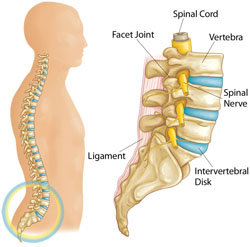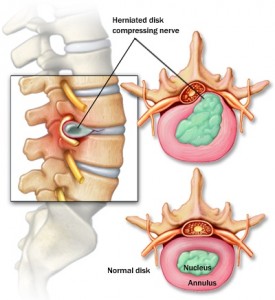The majority of us will suffer lower back pain at some point in our lives, whether this be a short bout, recurrent episodes or long term chronic pain. The exact cause of the pain is largely undiagnosable on scans or physical assessment.

Your spine is made up of boney vertebrae which are separated by gel like centered discs that act as shock absorbers and deform slightly in all directions to allow movement of the spine. the vertebrae and discs are supported by large ligaments. You have small joints at each level called facet joints which are supported by smaller ligaments. Holding the spine is a multitude of muscles providing strength and stability. Your spinal cord runs through the centre of the spine with little spinal nerves exiting at each level.
Types of lower back pain?
Non-specific
The most common type is non-specific low back pain. A large number start with a sudden onset of pain (acute) and is the type most people will experience at some point in their lives. It is generally not clear as to what causes the pain hence the term non-specific.

Nerve root pain
In certain cases the back pain is accompanied by nerve root pain (sometimes called sciatica). This is where one or more of the exiting spinal nerve roots has become irritated or compressed. This then causes symptoms beyond the spine into the buttock and sometimes down the leg. The majority of these are due to a bulging disc, sometimes called a slipped disc, although the disc does not actually slip out of place.
Cauda equina syndrome
This happens in very rare cases but it is a very serious condition. Nerves at the base of the spinal cord become compressed causing a number of unusual symptoms. If present this is a medical emergency and requires immediate attention. More on the symptoms later on.
What causes low back pain?
In a lot of cases back pain is of sudden onset. It may be caused by lifting something heavy, twisting or even sneezing.
Whilst it is difficult to pinpoint a specific structure at fault it is thought the majority of cases are through ligament sprain or muscle strain. This is usually caused through overstretching or straining, poor postures and having generally de-conditioned muscles adding additional load to the ligaments and discs of the spine.
What are the symptoms of low back pain?
Back pain can come on suddenly with an easily attributable cause such as lifting or develop more gradually which is harder to pinpoint a reason. Some people just wake up one day with pain. Generally the risk factors were already present. The pain can be central or to one side. It can also radiate across the back. This pain can range from mild to severe and can spread into the buttocks. If a nerve root is trapped then pain, pins and needles or numbness can be felt down the leg.
If the Cauda equina is compressed you may have additional symptoms such as the inability to pass urine, numbness between the legs and around the anus and weakness in one or both legs. As mentioned before, this is a medical emergency and you should seek immediate attention from your local A&E department to avoid risk of permanent damage.
Most back pain will settle in a number of weeks but if the cause is not addressed it will return in the future, perhaps several times a year. Some cases don’t resolve in weeks and can continue for months. This is called chronic low back pain.
Simple advice
Fortunately, although most back pain is non-specific, the management is the same. You should continue with normal activities as best you can although this may be difficult in the first few days. It is best to keep moving rather than sit down. Try not to do anything that causes too much pain but expect some discomfort whilst trying to remain mobile. Returning to work as soon as possible has been shown reduce the recovery rate of your injury.
Avoid heavy bending or lifting whilst your back pain is settling.
In the past the advice was always to rest however this has now been shown in clinical research to actually increase the healing time and is not advisable.
If you need painkillers then take then regularly rather than sporadically. You can discuss this with your GP or pharmacist but on the whole this may help to to keep mobile.
Treatment
Strengthening exercises
This is key to giving you long term improvements in your back pain and preventing further episodes in the future. A progressive strengthening programme to ensure your muscles are providing sufficient support to the joints and ligaments of your spine is essential.
Joint mobilisation
Manual therapy to the joints of your spine to help with pain relief and improve mobility. This can provide an important window of opportunity to do the key work that is required to improve your back pain long term.
Soft tissue massage
Also useful in reducing pain by relieving tension in the muscles of your spine.
Acupuncture
This involves the insertion of very fine needles and is another method of pain relief.
Stretching
Modern life puts us in sustained postures that result certain muscle groups becoming tight. This prevents the spine moving as freely as it should. Stretching these contracted muscles will help allow you to position your spine as intended.
Lifestyle advice
In most cases back pain is the result of our lifestyles both at work and at home. Little changes here and there can make a huge difference to your pain.
At Vfit Physiotherapy we package all of this into our Back Fit programme

